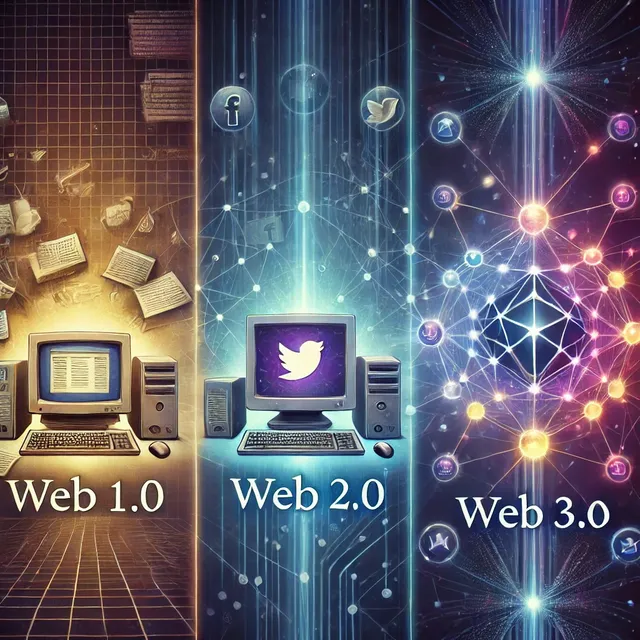The Rise of Web 3.0: Understanding the Next Internet Generation
In the age of technology and the internet, there is a continuous evolution in the way we interact with the digital world. Over recent years, we have witnessed the emergence of a new generation of the internet: Web 3.0. This generation leverages decentralized blockchain technology and introduces advanced technical skills and a digital culture distinct from previous generations. While Web 3.0 offers numerous advantages, it also brings new challenges, such as concerns over privacy and content control. In this article, we will delve into the essence of Web 3.0 and blockchain technology, explore how this generation interacts with technology and the internet, and discuss ways to harness its opportunities to achieve various goals. Additionally, we will examine the challenges faced by this generation and how societies, governments, and companies can address these challenges and capitalize on the opportunities it provides.
Note: While some references argue that the internet comprises more than three generations, for the average user or those interested in crypto and the metaverse, the internet is often categorized into three primary generations.
Understanding Web 1.0 and Web 2.0
Before diving into Web 3.0, let us briefly explore the first and second generations of the internet.
The internet originated in the 1960s as a means of transmitting information between governments. However, it was initially local—transferring data within the same room from one device to another. Back then, computers were expensive and large, used primarily for data storage. The true motivation for creating the internet arose during the Cold War. When the Soviet Union began transmitting data via the Sputnik satellite, the United States realized the need for an uninterruptible communication system. This led to the establishment of committees and, eventually, the birth of the internet in 1983. Although numerous developments occurred between 1960 and 1983, they are beyond the scope of this discussion.
Web 1.0 began in the 1990s, introducing a static internet where users could only read information on connected pages without interaction or modification—much like reading a newspaper. During this phase, users were merely consumers of content.
Web 2.0 emerged around 2004 and continues to dominate today. This generation brought a significant shift, allowing users to interact, create, and share content. Platforms like Facebook and YouTube began collecting user data to tailor content and keep users engaged longer. While this interactivity enabled companies to generate substantial revenue, it also raised concerns about excessive privacy violations. Initially, personalized content based on user interests seemed beneficial, but the situation escalated when companies started gathering sensitive information, such as location data, leading to concerns about the misuse of personal data.
-Enter Web 3.0: The Decentralized Internet
Web 3.0 introduces blockchain technology, which emphasizes decentralization. Unlike Web 2.0, where companies profit by monetizing user data, Web 3.0 aims to give ownership back to the users. This revolutionary concept allows individuals to control their digital assets and content. However, the transition is not without challenges, as capitalistic corporations are unlikely to relinquish control easily.
One of the defining features of Web 3.0 is its reliance on blockchain rather than centralized servers or physical storage devices. This decentralization ensures that no single entity can delete published content. Platforms operating on Web 3.0 lack managers or employees; users own and control their data entirely. While this autonomy is empowering, it also raises concerns about the potential spread of harmful or undesirable content.
For instance, Web 3.0 enables unrestricted sharing of sensitive topics, such as human rights violations, without interference from corporate policies that label such content as violent or inappropriate. Similarly, users can voice opinions against societal norms without facing censorship. However, the lack of regulatory oversight presents challenges in managing harmful or unethical content.
It is essential to note that Web 3.0 is more of a concept representing the future of the internet rather than a specific technology. In a capitalistic world, many companies exploit the term “Web 3.0” as a marketing strategy. Nonetheless, the core idea remains—a decentralized internet where users regain control over their digital presence.
- Conclusion
Web 3.0 marks a transformative phase in the evolution of the internet, emphasizing user ownership and decentralization. While it presents remarkable opportunities for innovation and empowerment, it also poses significant challenges that require careful consideration. Governments, societies, and companies must navigate these complexities to create a balanced ecosystem that fosters creativity, protects privacy, and mitigates risks. As we stand on the brink of this new digital era, the promise of Web 3.0 lies in its potential to redefine our relationship with the internet and unlock a future of endless possibilities.
